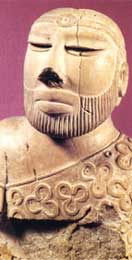|
|
| Remains of the past |
The Aryan Debate
Edited by Thomas R. Trautmann,
Oxford, Rs 545
The controversy about whether the Aryans were foreigners who destroyed the Dravidian Indus Valley Civilization or whether they were indigenous inhabitants of India, who were the founding fathers of both the Indus and the subsequent Vedic civilizations, has become a highly politicized issue. While the Marxists go for the former view, the proponents of Hindutva prefer the second. In this volume, part of the OUP series ‘Debates in Indian History and Society’, Thomas R. Trautmann has collected 18 articles which show the evolution of this debate in the last two and a half centuries.
Various experts from comparative philology, archaeology and history have contributed to the Aryan debate. It began in 1786 when William Jones, using historical linguistics, proved that Sanskrit, Persian, Greek, Celtic and Latin had descended from a common Indo-European language. In 1816 Bishop Robert Caldwell discovered the Dravidian languages spoken by inhabitants of the deep south.
Following the discovery of the Indus Valley Civilization in 1924, John Marshall argued, on the basis of a pseudo-biological racial theory, that around 1200 BC the dark-skinned Dravidians of the Indus Valley cities were destroyed by the fair-skinned Indo-Aryans, who entered India from Iran through the North-west frontier passes.
From the end of the 20th century, the Aryan intrusion theory has been modified significantly by liberal Marxists. The invasion theory has been discarded in favour of the migration theory. In 1999, Romila Thapar claimed that instead of invading India, the Aryans entered through the North-west peacefully. Anthropologists no longer accept the racial and physical differences between Aryans and Dravidians. In 2001, Shereen Ratnagar argued that the Harappan Civilization collapsed because, around 1800 BC, its overseas trade with Mesopotamia closed down. However, Colin Renfrew, S.P. Gupta and B.B. Lal pushed for a re-evaluation of the existing picture. The indigenous origin of the Aryans received a shot in the arm with the discovery of cuneiform script in Turkey which could be dated to 1380 BC. It mentions the name of Vedic gods like Indra and Varuna.
In 1997, Sandor Bokonyi claimed that dental remains of domesticated horses have been excavated from the Indus sites. These horses were imported from Ukraine before 1200 BC, the time when the Aryans arrived. Lal argues that this proves that the Aryans, who knew the use of horses, formed the Indus Valley Civilization. In 1999, Gupta claimed that while 150 sites were excavated along the river Indus, 250 sites could be identified along the bank of the river Saraswati in Rajasthan. Around 2000 BC, due to plate tectonic changes, Saraswati vanished and became the desert of Cholistan. Then the Aryans migrated from the Indus-Saraswati basin and founded the Vedic Civilization along the Ganga-Jamuna doab.
The two sides of the debate, despite substantial differences, share a common ground. Neither accepts the theory of the destruction of the Indus Valley Civilization by the Aryan invasion. Both emphasize continuity rather than discontinuity between the Indus and Vedic civilizations. Trautmann rightly says that until the Indus script is interpreted, we cannot reach any decisive conclusion regarding the interrelationship between the Indus and Vedic cultures. He deserves praise for presenting the complex issues of the Aryan debate lucidly for the non-specialists.


